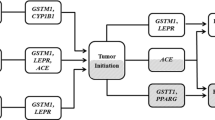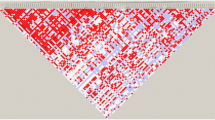Abstract
CD44 is involved in cancer-cell growth, invasion, proliferation and metastasis and is also a causal factor for acquisition of resistance to apoptosis. Therefore we evaluated different SNPs of CD44 gene viz. CD44rs187116 A/G, CD44rs4755392 A/T, CD44rs187115 C/T, CD44rs13347 C/T and CD44 rs353639 G/T for bladder cancer risk in North Indian population. 240 bladder cancer patients and 270 cancer free controls were recruited in this study. Genotyping was done by PCR–RFLP for CD44rs187116 A/G. However, CD44rs4755392 A/T, CD44rs187115 C/T, CD44rs13347 C/T and CD44 rs353639 G/T were genotyped by allelic discrimination Taqman® assay. Statistical analysis was done by SPSS. In-silico analysis was done using F-SNP. We found reduced risk in variant genotype, TT of rs4755392 (p = 0.011) as well as in variant allele, T (p = 0.045). No risk was seen in rs13347, heterozygous genotype, CT (p = 0.023) and variant allele, T (p = 0.007). The dominant model, CT + TT also revealed reduced risk (p = 0.009). A marginal risk was seen in dominant model, GT + TT of rs353639 (p = 0.044) and reduced risk in variant allele T (p = 0.040). A significant manifold risk was seen in smokers carrying variant genotype, TT of CD44rs353639 G/T (p = 0.038, OR 1.960). Haplotypic analysis revealed significant association in 4 sets viz. TCCGG p = 0.005, TTCGA p = 0.039, ACTGG p = 0.008 and TCTGA p = 0.006. In-silico analysis using F-SNP, showed altered transcriptional regulation for rs187115, rs13347 and rs353639. Our study suggests that rs353639 shows a marginal risk for bladder cancer susceptibility, whereas rs4755392 and rs13347 have reduced risk of bladder cancer and rs187115 and rs187116 had no effect on bladder cancer susceptibility in North Indians.

Similar content being viewed by others
References
American Cancer Society. Cancer facts and figures 2015. Atlanta: American Cancer Society; 2015.
Ferlay J, Soerjomataram I, Ervik M, et al. GLOBOCAN 2012 v1.0, Cancer incidence and mortality worldwide: IARC CancerBase No. 11 [Internet]. Lyon: International Agency for Research on Cancer; 2013. http://globocan.iarc.fr. Accessed Dec 2013.
Murthy NS, Nandakumar BS, Pruthvish S, George PS, Mathew A. Disability adjusted life years for cancer patients in India. Asian Pac J Cancer Prev. 2010;11(3):633–40.
Götte M, Yip GW. Heparanase, hyaluronan, and CD44 in cancers: a breast carcinoma perspective. Cancer Res. 2006;66:10233–7.
Marhaba R, Zöller M. CD44 in cancer progression: adhesion, migration and growth regulation. J Mol Histol. 2004;35:211–31.
Joshua B, Kaplan MJ, Doweck I, Pai R, Weissman IL, Prince ME, et al. Frequency of cells expressing CD44, a head and neck cancer stem cell marker: correlation with tumor aggressiveness. Head Neck. 2012;34:42–9.
Draffin JE, McFarlane S, Hill A, Johnston PG, Waugh DJ. CD44 potentiates the adherence of metastatic prostate and breast cancer cells to bone marrow endothelial cells. Cancer Res. 2004;64:5702–11.
Ponta H, Sherman L, Herrlich PA. CD44: from adhesion molecules to signaling regulators. Nat Rev Mol Cell Biol. 2003;4(1):33–45.
Park YS, Huh JW, Lee JH, Kim HR. shRNA against CD44 inhibits cell proliferation, invasion and migration, and promotes apoptosis of colon carcinoma cells. Oncol Rep. 2012;27(2):339–46. doi:10.3892/or.2011.1532 Epub 2011 Nov 8.
Kaufman DS, Shipley WU, Feldman AS. Bladder cancer. Lancet. 2009;374:239–49.
Walker CL, Ho S. Developmental reprogramming of cancer susceptibility. Nat Rev Cancer. 2012;12(7):479–86. doi:10.1038/nrc3220
Colombel M, Soloway M, Akaza H. Epidemiology, staging, grading and risk stratification of bladder cancer. Eur Urol. 2008;7(Suppl.):618–26.
Barrett JC, Fry B, Maller J, Daly MJ. Haploview: analysis and visualization of LD and haplotype maps. Bioinformatics. 2005;21:263–65.
Miller SA, Dykes DD, Polesky HF. A simple salting out procedure for extracting DNA from human nucleated cells. Nucleic Acids Res. 1988;16:1215.
Winder T, Ning Y, Yang D, Zhang W, Power DG, Bohanes P, et al. Germline polymorphisms in genes involved in the CD44 signaling pathway are associated with clinical outcome in localized gastric adenocarcinoma. Int J Cancer. 2011;129:1096–104.
Lee PH, Shatkay H. F-SNP: computationally predicted functional SNPs for disease association studies. Nucleic Acids Res. 2008;36:D820–4.
Tremmel M, Matzke A, Albrecht I, Laib AM, Olaku V, Ballmer-Hofer K, et al. A CD44v6 peptide reveals a role of CD44 in VEGFR-2 signaling and angiogenesis. Blood. 2009;114:5236–44.
Screaton GR, Bell MV, Jackson DG, Cornelis FB, Gerth U, Bell JI. Genomic structure of DNA encoding the lymphocyte homing receptor CD44 reveals at least 12 alternatively spliced exons. Proc Natl Acad Sci USA. 1992;89:12160–64.
Jiang L, Deng J, Zhu X, Zheng J, You Y, Li N, et al. CD44 rs13347 C > T polymorphism predicts breast cancer risk and prognosis in Chinese populations. Breast Cancer Res. 2012;14:R105.
Zhou J, Nagarkatti PS, Zhong Y, Creek K, Zhang J, Nagarkatti M. Unique SNP in CD44 intron 1 and its role in breast cancer development. Anticancer Res. 2010;30:1263–72.
Guo YJ, Liu G, Wang X, Jin D, Wu M, Ma J, et al. Potential use of soluble CD44 in serum as indicator of tumor burden and metastasis in patients with gastric or colon cancer. Cancer Res. 1994;54:422–6.
Van Hal NL, Van Dongen GA, Ten Brink CB, Heider KH, Rech-Weichselbraun I, Snow GB, et al. Evaluation of soluble CD44v6 as a potential serum marker for head and neck squamous cell carcinoma. Clin Cancer Res. 1999;5:3534–41.
Gerger A, Zhang W, Yang D, Bohanes P, Ning Y, Winder T, et al. Common cancer stem cell gene variants predict colon cancer recurrence. Clin Cancer Res. 2011;17:6934–43.
Xiao M, Hu S, Zhang L, Huang J, Jiang H, Cai X. Polymorphisms of CD44 gene and nasopharyngeal carcinoma susceptibility in a Chinese population. Mutagenesis. 2013;28:577–82.
Tulsyan S, Agarwal G, Lal P, Agrawal S, Mittal RD, Mittal B. CD44 gene polymorphisms in breast cancer risk and prognosis: a study in North Indian population. PLoS One. 2013;8:e71073.
Woodman AC, Sugiyama M, Yoshida K, Sugino T, Borgya A, Goodison S, et al. Analysis of anomalous CD44 gene expression in human breast, bladder, and colon cancer and correlation of observed mRNA and protein isoforms. Am J Pathol. 1996;149:1519–30.
Trapasso S, Allegra E. Role of CD44 as a marker of cancer stem cells in head and neck cancer. Biologics. 2012;6:379–83.
Vazquez A, Grochola LF, Bond EE, Levine AJ, Taubert H, Müller TH, et al. Chemosensitivity profiles identify polymorphisms in the p53 network genes 14-3-3tau and CD44 that affect sarcoma incidence and survival. Cancer Res. 2010;70(1):172–80.
Chou YE, Hsieh MJ, Hsin CH, Chiang WL, Lai YC, Lee YH, et al. CD44 gene polymorphisms and environmental factors on oral cancer susceptibility in Taiwan. PLoS One. 2014;9:e93692.
Qiu Y, Hu Y, Zhang ZY, Ye L, Xu FH, Schneider ME, et al. Genetic association of osteopontin (OPN) and its receptor CD44 genes with susceptibility to Chinese gastric cancer patients. J Cancer Res Clin Oncol. 2014;140:2143–56.
Sharma KL, Yadav A, Gupta A, Tulsayan S, Kumar V, Misra S, et al. Association of genetic variants of cancer stem cell gene CD44 haplotypes with gallbladder cancer susceptibility in North Indian population. Tumour Biol. 2014;35:2583–9.
Author information
Authors and Affiliations
Corresponding author
Ethics declarations
Conflict of interest
Authors have no conflicts of interest in this work.
Rights and permissions
About this article
Cite this article
Verma, A., Kapoor, R. & Mittal, R.D. Cluster of Differentiation 44 (CD44) Gene Variants: A Putative Cancer Stem Cell Marker in Risk Prediction of Bladder Cancer in North Indian Population. Ind J Clin Biochem 32, 74–83 (2017). https://doi.org/10.1007/s12291-016-0580-y
Received:
Accepted:
Published:
Issue Date:
DOI: https://doi.org/10.1007/s12291-016-0580-y




